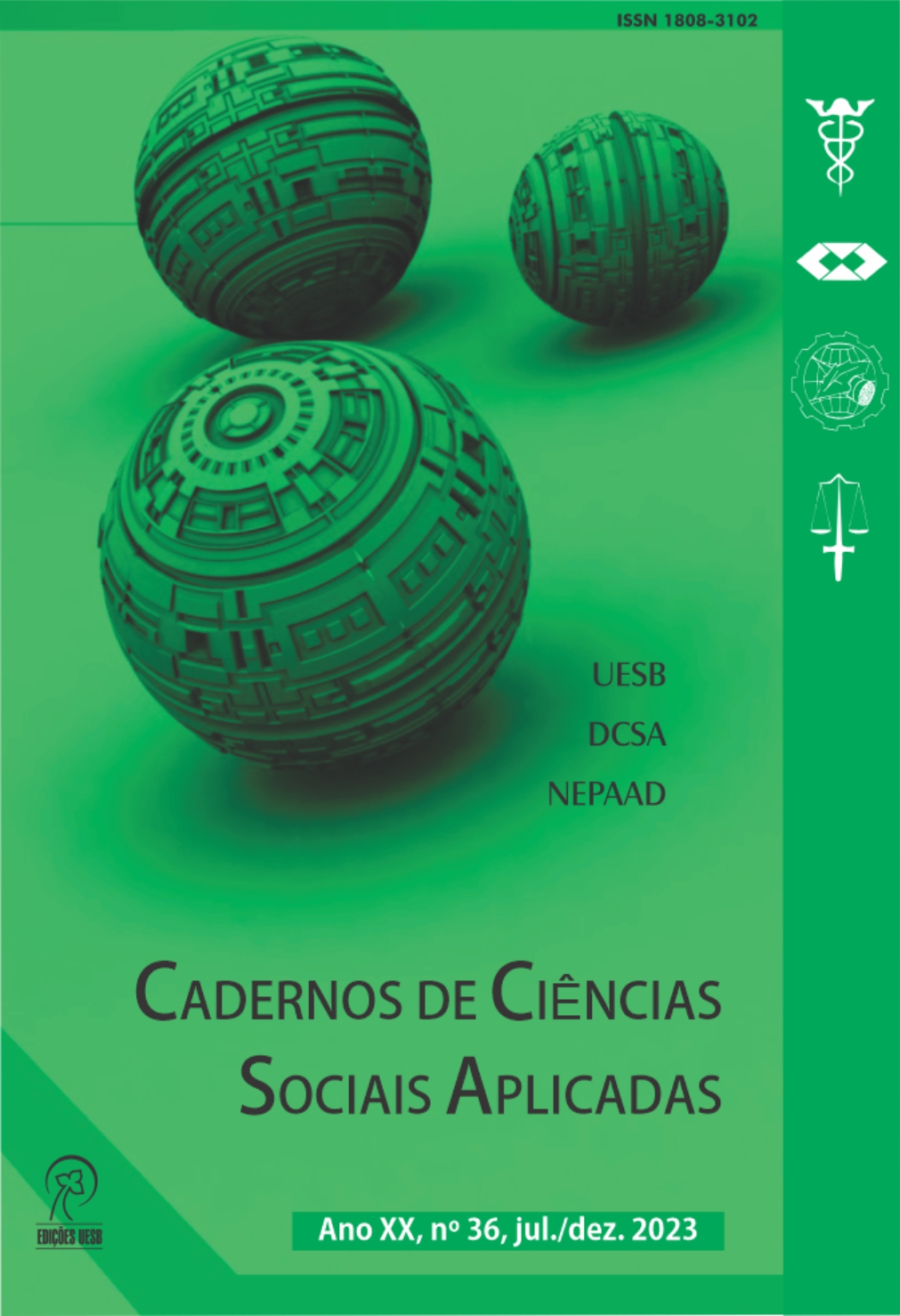An analysis on the interrelations between conceptions and quasi-myths about corruption
DOI:
https://doi.org/10.22481/ccsa.v20i36.11662Keywords:
Corruption, Culture, Economics, Politics, Quasi-mythsAbstract
Abstract:This article centers its analysis on a three-dimensional understanding of the causes and impacts
of corruption. The objective was to elucidate the intersection between the phenomenon of corruption and
the economic, political and cultural contexts of a nation, in order to promote a better understanding of the
complexity that surrounds the subject. In order to achieve this goal, concepts and data collected from the
specialized scientific literature and technical materials published by scholars in the area were examined, a
process that had as its starting point the investigations carried out by Professor Matthew Stephenson.
Throughout the study, it was demonstrated that, despite the harmful effects they cause to society, corrupt
practices persist and can be stimulated by distorted views about the economic, political and cultural
conceptions that qualify the concept of corruption. Some of these narratives (quasi-myths), analyzed by
Stephenson, are widespread and capable of inhibiting attempts to fight corruption effectively. In
conclusion, one can observe a movement that is characterized by an active role, by influencing and
shaping the functioning of the economy, politics and culture of a country, as well as by a passive role,
which stems and develops from these contexts.
Downloads
References
BANERJEE, Abhijit. A Theory of Misgovernance, The Quarterly Journal of Economics,
volume 112, issue 4, p. 1289-1332. Disponível em: <https://bityli.com/Z1jyu>. Acesso em: 19
jun. 2021.
BANFIELD, Edward C. The Moral Basis for a Backward Society, The Free Press, Glencoe,
Illinois. Disponível em: <https://bityli.com/TNjNl>. Acesso em: 28 mai. 2021.
BARRO, Robert J. The control of Politicians: an Economic Model, Public Choice, p. 19-42.
Disponível em: <https://link.springer.com/article/10.1007/BF01718440>. Acesso em: 04 jul.
BECKER, Gary S. Crime and punishment: an economic approach. Disponível em:
<https://bityli.com/5bOdg>. Acesso em: 04 jul. 2021.
BOHN, Frank. Grand corruption instead of commitment? Reconsidering timeinconsistency of monetary policy, Journal of International Money and Finance,
volume 32,2013, p. 478-490.Disponível em: <https://bityli.com/qpbDx>. Acesso em: 13 jun. de
DA SILVA, Carlos Eduardo Lins. Journalism and corruption in Brazil, Combating
Corruption in Latin America, p. 173. Disponível em: <https://bityli.com/1fUfB>. Acesso em:
jul. 2021.
DEARDORFF, A.V. Deardorffs’ Glossary of International Economics. Disponível em:
<http://www-personal.umich.edu/~alandear/glossary/>. Acesso em: 18 jun. 2021.
EISENHARDT, Kathleen M. Agency and institutional theory explanations: the case of
retail sales compensation, The Academy of Management Journal, vol. 31, 1988, p. 488-
Disponível em: <https://www.jstor.org/stable/256457>. Acesso em: 13 jun. 2021.
HARVARD LAW SCHOOL. Corruption and Anticorruption: A talk by Professor Matthew
Stephenson. Disponível em: <https://www.youtube.com/watch?v=V6t0Tzn2ZSU>. Acesso
em: 15 mai. 2021.
HOFSTEDE, Geert. National cultures in four dimensions. International Studies of
Management and Organisation, vol. 13, p. 46-74. Disponível
em:<https://www.jstor.org/stable/40396953>. Acesso em: 29 jun. 2021.
HUNTINGTON, Samuel. Political order in changing societies. Disponível em:
https://brandonkendhammer.com/politics_of_development/wpcontent/uploads/2018/09/Huntington-1968.pdf>. Acesso em: 17 jul. 2021.
HUSTED, Bryan W. Wealth, Culture, and Corruption, Journal of International Business
Studies, 1999, vol. 30, issue 2, p. 339-359.Disponível em: <https://bityli.com/CK77S>. Acesso
em: 29 jun. 2021.
JOHNSTON, Michael. Public Officials, Private Interests, and Sustainable democracy:
When Politics and corruption Meet. Disponível em: <https://bityli.com/9vXJ5>. Acesso em: 25 jul. 2021.
KAUFMANN, Daniel; VICENTE, Pedro C. Legal corruption. Disponível em:
<https://papers.ssrn.com/sol3/papers.cfm?abstract_id=829844>. Acesso em: 17 jul. 2021.
KLAŠNJA, Marko; TUCKER, Joshua A.; DEEGAN-KRAUSE, Kevin. Pocketbook vs.
sociotropic corruption voting, British Journal of Political Science. Disponível em:
<https://bityli.com/81cIh>. Acesso em: 17 jul. 2021.
KNOERR, Fernando Gustavo; GUARAGNI, Fábio André; KNESEBECK, Eduardo Henrique.
Efeitos econômicos da corrupção. Disponível em: <https://bityli.com/ryFzl>. Acesso em:
Acesso em: 17 jun. 2021.
LEFF, Nathaniel. Economic Development through Bureaucratic Corruption, American
Behavioral Scientist, vol. 8, issue 3, p. 8–14. Disponível em: <https://bityli.com/NlctU>. Acesso
em: 12 jul. 2021.
LEITE, Carlos; WEIDMAN, Jens. Does Mother nature corrupt? Natural resources,
corruption, and Economic Growth. Disponível em:
<https://www.imf.org/external/pubs/ft/wp/1999/wp9985.pdf>. Acesso em: 05 jul. 2021.
LESSIG, Lawrence. Foreword: “Institutional corruption” defined, Journal of Law, Medicine
& Ethics, vol. 41, issue 3, p. 553-555. Disponível em: <https://bityli.com/5Krwi>. Acesso em:
jul. 2021.
MAGALHÃES, Pedro C. Government effectiveness and support for democracy. Disponível
em: <https://www.ics.ulisboa.pt/fcteval/papers/Magalhaes14.pdf>. Acesso em: 25 jul. 2021.
MAURO, Paolo. Corruption and Growth, The Quarterly Journal of Economics, vol. 110, 1995,
p. 681-712.Disponível em: <https://www.jstor.org/stable/2946696>. Acesso em: 18 jun. 2021.
MAYO, Robert L. Does bribery grease the wheels of economic growth? Disponível em:
<https://bityli.com/BhYLO>. Acesso em: 18 jun. 2021.
MCSWEENEY, Brendan. Hofstede’s model of national culture differences: a triumph of
faith – a failure of analysis, Human Relations, p. 89-118. Disponível em:
<https://bityli.com/ELHr7>. Acesso em: 28 mai. 2021.
MESSNER, Steven F.; ROSENFELD, Richard. Political restraint of the market and levels of
criminal homicide: a cross national application of the institutional anomie theory.
Disponível em: <https://bityli.com/jF6uD>. Acesso em: 29 jun. 2021.
NOEL, Johnson; WILLIAM, Ruger; JASON, Sorens; STEVEN, Yamarik. Corruption as a
response to regulation. Disponível em: <https://bityli.com/mBZNr>. Acesso em: 05 jul.
NUR-TEGIN, Kanybek; CZAP, Hans J. Corruption: Democracy, Autocracy, and Political
Stability, Economic Analysis and Policy, Elsevier, vol. 42, p. 51-66. Disponível em:
<https://bityli.com/ZOsYD>. Acesso em: 25 jul. 2021.
PALDAM, Martin. The cross-country pattern of corruption: economics, culture and the
seesaw dynamics. Disponível em: <https://bityli.com/hMryG>. Acesso em: 12 jul. 2021.
PHILP, Mark. Access, accountability and authority: Corruption and the democratic
process, Crime, Law and Social Change, vol. 36, p. 357–377. Disponível em:
<https://doi.org/10.1023/A:1012075027147>. Acesso em: 24 jul. 2021.
SUNG, Hung-En. A convergence approach to the analysis of political corruption: a cross
national study, Crime, Law and Social Change, vol. 38, p. 137–160.Disponível em:
<https://bityli.com/Xevc9>. Acesso em: 24 jul. 2021.
TRANSPARENCY INTERNATIONAL. Corruption Perception Index. Disponível em:
<https://www.transparency.org/>. Acesso em: 17 jun. 2021.
TREISMAN, Daniel. The causes of corruption: A cross-national Study, Journal of Public
Economics, p. 399–457. Disponível em: <https://bityli.com/N5qkN>. Acesso em: 05 jul. 2021.
Downloads
Published
Issue
Section
License
Copyright (c) 2023 Cadernos de Ciências Sociais Aplicadas

This work is licensed under a Creative Commons Attribution 4.0 International License.












